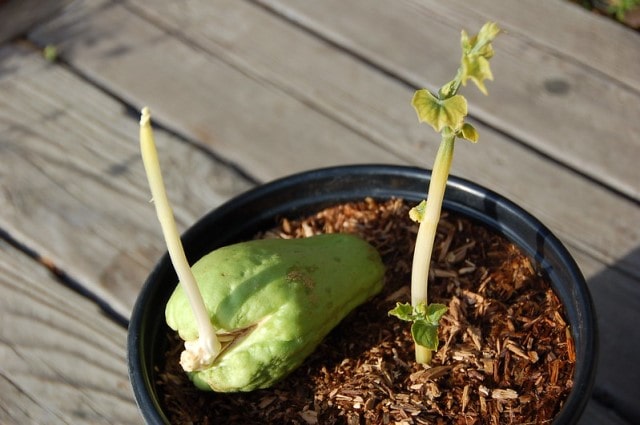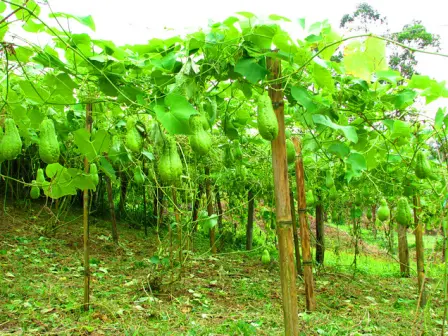Do you want to grow chayote squash at home? If so, these tips will help you to grow chayote squash without any difficulty. Chayote squash is loved by many because of its fleshy meat that can be used with curry, and salad.
Growing chayote squash is a rewarding experience, and with the right care, you can enjoy a bountiful harvest. Here are the steps to successfully grow chayote squash:

- Selecting a Suitable Location: Choose a sunny spot in your garden that receives at least 6-8 hours of direct sunlight daily. Chayote squash thrives in warm climates and requires a frost-free environment.
- Preparing the Soil: Ensure the soil is well-draining and rich in organic matter. You can amend the soil with compost or well-rotted manure to improve fertility and water retention. Chayote prefers a slightly acidic to neutral pH level (around 6.0 to 6.5).
- Obtaining Chayote Fruit: Chayote can be grown from a whole fruit or from the sprouting seed inside. If using a whole fruit, allow it to sprout by leaving it in a warm, dry place for several weeks until it develops shoots. Alternatively, purchase chayote fruit with visible sprouts.
- Planting: Plant the chayote fruit or sprouted seed about 1-2 inches deep in the soil. If you’re planting multiple chayote plants, space them at least 10 feet apart, as they tend to spread vigorously.
- Providing Support: Chayote plants are prolific climbers. Install a sturdy trellis, arbor, or fence near the planting area to support the vines as they grow. This will help prevent damage to the fruits and make harvesting easier.
- Watering: Keep the soil consistently moist but not waterlogged. Water deeply and regularly, especially during dry spells. Applying a layer of mulch around the base of the plant can help retain soil moisture and suppress weeds.
- Fertilizing: Chayote plants benefit from regular feeding. Apply a balanced fertilizer with equal parts of nitrogen, phosphorus, and potassium every 4-6 weeks during the growing season to promote healthy growth and fruit production.
- Pruning: To encourage bushier growth and better fruit production, periodically prune the chayote vines. Trim back excessive growth, especially if it starts to overwhelm the support structure.
- Pest and Disease Management: Keep an eye out for common garden pests like aphids, snails, and slugs. Use organic pest control methods or insecticidal soap when needed. Also, watch for signs of fungal diseases in humid conditions.
- Harvesting: Chayote squash is ready for harvest when the fruits are firm and about the size of a small apple. Gently twist or cut them from the vines. Regularly harvesting ripe fruits encourages more production.
By following these steps and providing proper care, you can enjoy a successful chayote squash harvest in your home garden. With its versatility in culinary dishes, chayote can be a delightful addition to your homegrown produce.
Trellis for Chayote Squash

A chayote squash trellis is a garden structure designed to support the robust growth of chayote vines. Chayote plants are natural climbers, and without proper support, their vines can become tangled and sprawl uncontrollably. A well-constructed trellis not only helps maximize space but also promotes better air circulation, which can reduce the risk of fungal diseases.
The ideal chayote trellis should be sturdy and capable of withstanding the weight of mature plants laden with fruits. It should stand at least 6 to 8 feet tall to accommodate the upward growth of chayote vines. Materials like wooden stakes, bamboo poles, or metal posts are commonly used to create the trellis structure.
Horizontal and vertical lines or grids can be added to the trellis to guide the chayote vines as they climb. As the vines grow, gently secure them to the trellis using soft ties or twine to prevent damage. Properly supporting your chayote squash with a trellis not only saves space but also makes harvesting easier and can lead to a more abundant and healthy crop.
Chayote Squash Plant Care
Chayote squash, also known as Sechium edule or vegetable pear, is a versatile and low-maintenance plant that produces delicious and nutritious fruits. Proper care is essential to ensure a healthy and bountiful harvest. Here are some key tips for chayote squash plant care:
- Planting: Chayote squash thrives in warm climates. Choose a sunny location with well-draining soil. Plant chayote seeds or whole fruits with sprouts in the spring after the danger of frost has passed. Leave enough space between plants, as they can spread vigorously.
- Watering: Chayote plants require consistent moisture. Water them deeply and regularly, especially during dry spells. Mulching around the base of the plant can help retain soil moisture.
- Support: Chayote vines are vigorous climbers and can become quite heavy with fruit. Provide sturdy trellises or supports for the vines to grow on. This not only prevents damage to the fruits but also makes harvesting easier.
- Fertilizing: Chayote plants benefit from regular feeding. Use a balanced fertilizer with equal parts of nitrogen, phosphorus, and potassium. Apply it every 4-6 weeks during the growing season.
- Pruning: Prune chayote vines to control their growth and shape. Trim back excessive growth to encourage bushier, more manageable plants.
- Pest and Disease Management: Keep an eye out for common pests like aphids, snails, and slugs, which can damage the leaves and fruits. Additionally, watch for fungal diseases in humid conditions. Use organic pest control methods or insecticidal soap as needed.
- Harvesting: Chayote fruits are ready for harvest when they are firm and about the size of a small apple. Handle them with care, as they bruise easily. Regularly harvesting ripe fruits encourages more production.
- Storage: Store harvested chayote squash in a cool, dry place for up to several weeks. They can also be refrigerated for longer shelf life.
Chayote squash plant care is relatively straightforward, making it an excellent choice for both novice and experienced gardeners. With proper attention and care, you can enjoy a continuous supply of this delicious and versatile vegetable throughout the growing season.
Tips on Growing Chayote Squash
1.Chayote can be sprouted more easily from seed than fruit. Take a sharp knife to cut open the fruit to get the seed. Be careful not to cut the seed.
2. To get more fruits from a chayote squash plant, trim the suckers off.
3. This is a summer-season crop that grows best in tropical and subtropical regions. Florida, the Gulf Coast, and California have favorable chayote growing temperatures. If you are growing chayote in a cold place, place the container near the fireplace.
4. The lifespan of a chayote plant is many years as it is a perennial plant. It is best to get new plants from the old plant as the old plant gets diseases as time passes.
FAQs on Chayote Squash
Can you grow chayote indoors?
While chayote is typically grown outdoors due to its need for ample sunlight and space, you can attempt to grow it indoors if you have a spacious, well-lit area with a trellis or support structure. However, it’s challenging to provide the necessary conditions, so outdoor cultivation is more common for chayote.
Can you grow chayote from seed?
Yes, chayote can be grown from seeds. To do so, remove the seed from a mature chayote fruit, dry it, and then plant it in well-drained soil. Keep it warm and moist until it sprouts, and then transplant it to a sunny location. It’s also common to grow chayote from a whole chayote fruit or by planting a mature chayote with sprouts.
Where is chayote squash grown?
Chayote squash is primarily grown in warm or tropical regions worldwide. Common cultivation areas include Latin America (Mexico, Guatemala), Southeast Asia (Philippines, Thailand), the Caribbean (Haiti, Puerto Rico), India, Africa (Nigeria), Mediterranean countries (Spain, Italy), and certain parts of the United States (Florida, California).
MORE POSTS:

